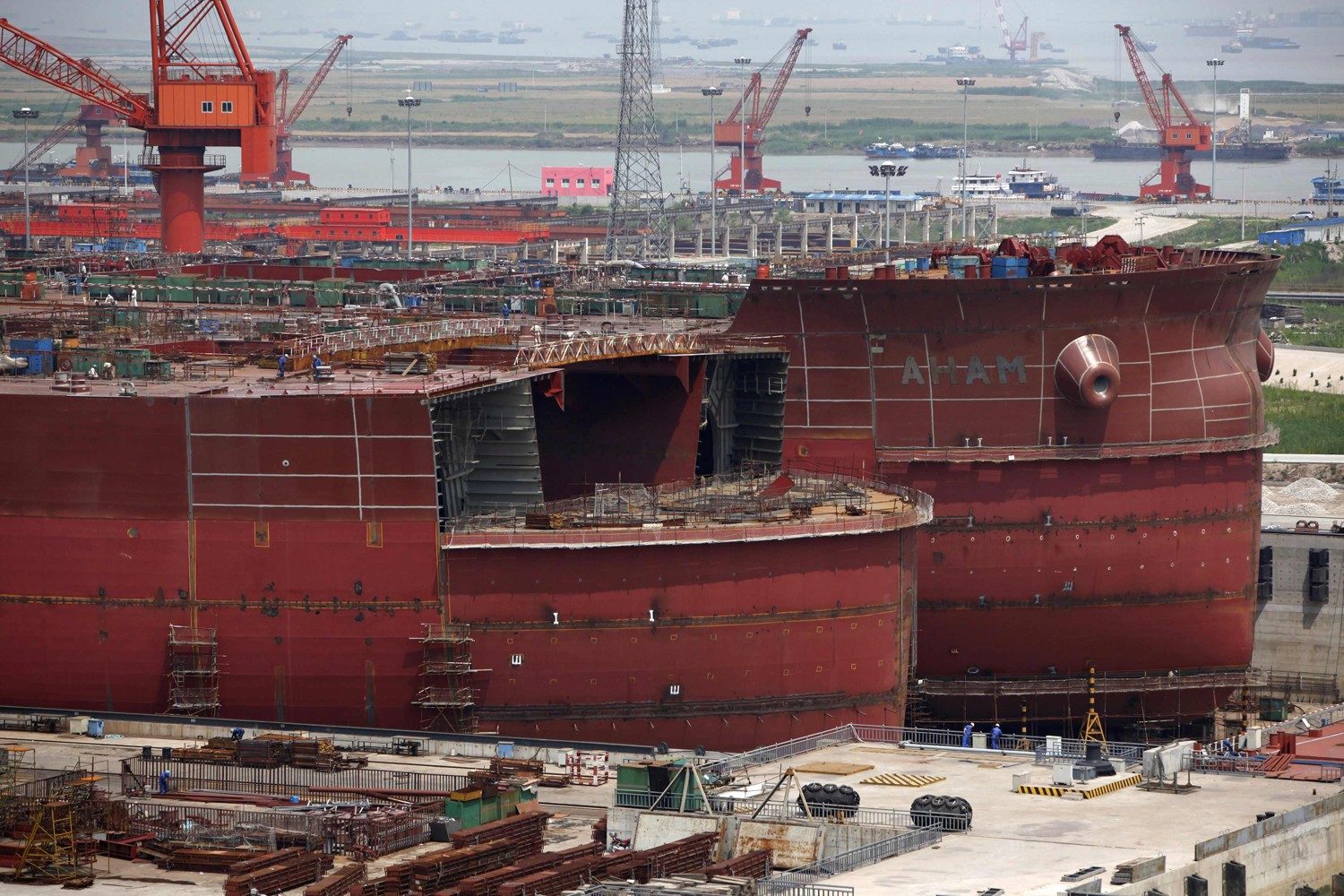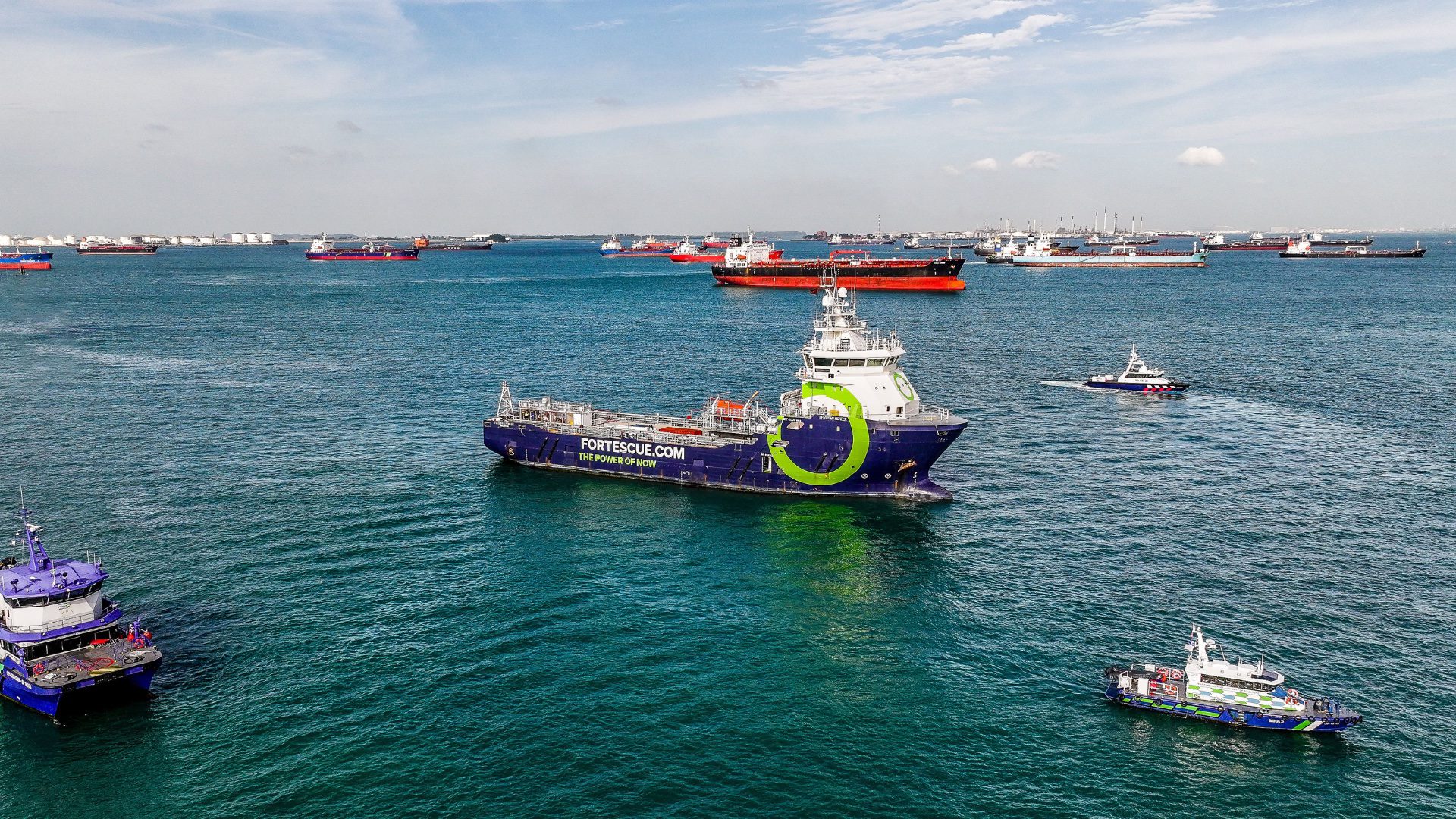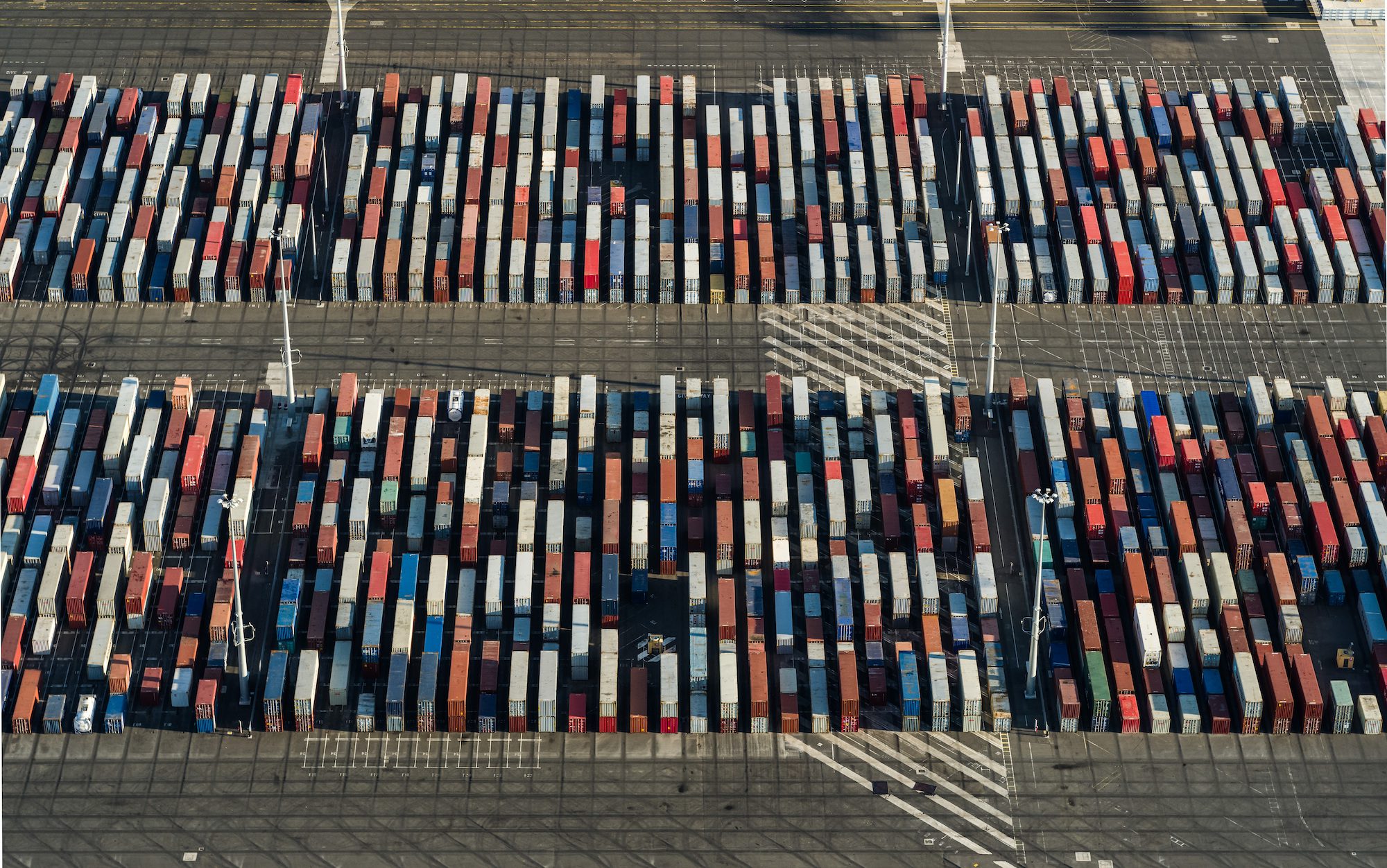Rongsheng Heavy Industries shipyard in Nantong, Jiangsu, file photo (c) REUTERS/Aly Song/Files
Nov. 19 (Bloomberg) — In China’s “Shipping Valley,” where the Yangtze River empties into the sea north of Shanghai, the once-bustling home of the nation’s biggest private shipbuilder is deadly quiet on a recent morning.
Rows of dilapidated five-story dormitories in the city of Nantong, previously housing China Rongsheng Heavy Industries Group Holdings Ltd.’s 38,000 employees, were abandoned after the shipbuilder teetering on collapse cut almost 80 percent of its workers over the past two years. Most video arcades, restaurants and shops serving them have closed.
A $6.6 trillion credit binge during the past five years, encouraged by Beijing policy makers as stimulus to combat a global economic slowdown, now threatens to stoke a debt crisis. At stake are trillions of yuan in bank loans that companies producing everything from ships to steel to solar power are struggling to repay as the world’s second-largest economy heads for the weakest annual expansion since 1999.
Rongsheng, which is seeking a government bailout after accumulating 25 billion yuan ($4.1 billion) in unpaid loans as of June, including to Bank of China Ltd., is a casualty of over- investment gone bust. In Nantong, the only remaining market is selling past-its-shelf-life bread, woolly shoe pads and other dusty items at a discount as shopkeeper Qiu Aibing prepares to wind down before winter. There’s no sign of a single customer.
“After I’m done selling all this stuff, I’ll be gone,” said Qiu, briefly lifting his eyes from a TV and casting a careless look at the half-empty shelves. “The workers didn’t have money to spend anyway because there’s no work to be done, and many of them haven’t been paid for months.”
Bad Loans
China’s biggest banks are already affected, tripling the amount of bad loans they wrote off in the first half of this year and cleaning up their books ahead of what may be a fresh wave of defaults. Industrial & Commercial Bank of China Ltd. and its four largest competitors expunged 22.1 billion yuan of debt that couldn’t be collected through June, up from 7.65 billion yuan a year earlier, regulatory filings show.
“In the next three to four years, industries with excess capacity will be the main source of credit loss for banks and their nonperforming loans as China cleans up the legacy,” said Liao Qiang, a Beijing-based director at Standard & Poor’s. “The speed of the process will depend on the government’s determination and whether they are willing to incur short-term pain for long-term gain.”
‘Very Painful’
Premier Li Keqiang, who took office in March, pledged to open the economy to market forces and strip power from the government in a process he described as “very painful and even feels like cutting one’s wrist.” In July, he vowed to curb overcapacity, which the government blames for driving down prices, eroding profits and generating pollution. Policy makers meeting in Beijing last week said they would elevate the role of markets in the nation’s economy.
China’s economy probably will expand 7.6 percent in 2013, the weakest pace since 1999, even as growth rebounded in the third quarter, according to the median estimate of economists surveyed by Bloomberg News.
Shang Fulin, China’s top banking regulator, this month urged lenders to “seek channels to clean up bad loans by industries with overcapacity to prevent new risks from brewing” and refrain from dragging their feet in dealing with the issue.
Credit Deterioration
China’s credit quality started to deteriorate in late 2011 as borrowers took on more debt to serve their obligations amid a slowing economy and weaker income. Interest owed by borrowers rose to an estimated 12.5 percent of China’s economy from 7 percent in 2008, Fitch Ratings estimated in September. By the end of 2017, it may climb to as much as 22 percent and “ultimately overwhelm borrowers.”
Meanwhile, China’s total credit will be pushed to almost 250 percent of gross domestic product by then, almost double the 130 percent of 2008, according to Fitch.
The nation might face credit losses of as much as $3 trillion as defaults ensue from the expansion of the past four years, particularly by non-bank lenders such as trusts, exceeding that seen prior to other credit crises, Goldman Sachs Group Inc. estimated in August.
Rongsheng, whose assets jumped sevenfold between 2007 and 2012 when government-directed lending led to a shipbuilding boom, also has loans outstanding to Export-Import Bank of China and China Development Bank Corp., state-owned policy banks set up to provide financial support at a cheaper cost to companies and industries endorsed by the government. Rongsheng may post a second consecutive loss of 2 billion yuan this year and a 1.1 billion yuan loss in 2014, according to a median estimate of analysts in a Bloomberg survey.
Delayed Salaries
Rongsheng now relies on its remaining 8,000 workers to build the world’s biggest cargo ships for Brazil’s iron-ore producer Vale SA and Oman Shipping Co., as well as smaller vessels and oil tankers. Workers in its shipyards, mostly from other parts of China, and local staff in its Shanghai office have had their salaries delayed, sometimes by two months, a person with knowledge of the matter said.
“I can still manage to survive by cutting expenses here and there, but many migrant workers can’t — not with only 20 yuan in their pockets and not knowing their next payday,” said Liu Guojun, a blue-uniformed dormitory maintenance and security worker who earns 2,000 yuan a month. “There’s a surge in theft and other petty crimes around here as a result.”
Rongsheng declined in an e-mail to answer questions about its operations. Spokesmen for ICBC and China Construction Bank Corp. declined to comment on the prospect of rising bad loans, while those at Bank of China, Agricultural Bank of China Ltd. and China Development Bank didn’t respond to requests.
Shipyard Shutdowns
The pain is being experienced by Rongsheng’s peers nationwide. A third of the country’s 1,600 shipyards may shut down within five years amid a global vessel glut, Wang Jinlian, secretary general of the China Association of the National Shipbuilding Industry, said in July.
To Ji Fenghua, chairman of Nantong Mingde Heavy Industry Group Co., another struggling “Shipping Valley” builder specializing in high-end vessels, that’s an understatement.
“I won’t be surprised if half of the shipbuilders fail, given the excess capacity,” said Ji, recounting the day in July 2012 that hundreds of his workers who hadn’t been paid in three months besieged his office building.
Repaying Banks
The company was strapped for cash as state-backed banks recalled their loans after the banking regulator ordered that new financing be stopped for shipbuilders and some other businesses. Deprived of new credit to pay off old debts, Ji and his fellow founders emptied their own bank accounts, collateralized their homes to banks and hit up relatives and acquaintances for cash.
“Every cent of the money we earned and borrowed was used to repay banks, leaving us nothing to pay workers or the suppliers,” Li said. “We have banks to thank for our boom, and we have them to blame for our doom.”
Mingde Heavy eventually survived the crisis with government help. Its cash shortage continues even as the company continues to take orders for stainless-steel chemical tankers.
The central government pledged 4 trillion yuan in economic stimulus during the global financial crisis starting in 2008. In 2009, Export-Import Bank of China committed to 160 billion yuan of credit to the nation’s two largest state-run shipbuilders, while Bank of China agreed to help smaller and private companies, according to statements from banks.
Easy access to credit helped Chinese banks churn out record profits and reduce bad-loan ratios to less than 1 percent as of June 30 from 2.8 percent at the end of 2008.
‘Industrial Glut’
“The 2008 stimulus exacerbated an industrial glut that has been in existence since 2003,” S&P’s Liao said. “We expect the government to take measured steps in a crackdown on overcapacity because they need to weigh the impact on financial stability.”
Nonperforming loans at Chinese banks increased for an eighth consecutive quarter in the three months ended Sept. 30 to 563.6 billion yuan, extending the longest streak in at least nine years. Still, they account for just 0.97 percent of the nation’s outstanding loans, according to the China Banking Regulatory Commission.
The bad-loan ratio could climb to as high as 1.5 percent in the next few quarters, according to Lian Ping, chief economist at Shanghai-based Bank of Communications Co. Most of the increase, he said, will come from the provinces of Jiangsu, where Nantong is located, and Zhejiang, south of Shanghai, where small businesses have been hit hard by the slowdown.
Turning Tide
In the first six months of this year, soured loans increased by 18 billion yuan in Jiangsu, more than any other Chinese province, followed by Zhejiang and Shanghai, the official Xinhua News Agency reported.
“There are many capital-and-labor-intensive industries that have relied on bank loans and policy support for their past success,” Lian of the Bank of Communications said. “But now the tide is turning against them.”
Shipbuilding isn’t the only industry affected by overcapacity. Also in Jiangsu, about 130 kilometers (80 miles) southwest of Nantong, Wuxi Suntech Power Co., the main unit of the industry’s once-biggest supplier, went bankrupt with 9 billion yuan of debt to China’s largest banks, according to a Nov. 12 report by Communist Party-owned Legal Daily. Suntech Power Holdings Co., the parent firm, defaulted on $541 million of offshore bonds to Wall Street investors.
Solar Panels
About 1 gigawatt of solar-panel production, more than 40 percent of the company’s 2011 module manufacturing capacity, was idled at one of two factories, according to a statement issued by Shunfeng Photovoltaic International Ltd., which agreed to buy Wuxi Suntech on Nov. 1 for 3 billion yuan. A gigawatt is about as much as what a new nuclear reactor can supply.
Government and banks’ support for the solar industry since late 2008 has resulted in at least one factory producing sun- powered products in half of China’s 600 cities, according to the China Renewable Energy Society in Beijing. China Development Bank, the world’s largest policy lender, alone lent more than 50 billion yuan to solar-panel makers as of August 2012, data from the China Banking Association showed.
China accounts for seven of every 10 solar panels produced worldwide. If they ran at full speed, the factories could produce 49 gigawatts of solar panels a year, 10 times more than in 2008, according to data compiled by Bloomberg. Overcapacity has driven down prices to about 84 cents a watt, compared with $2 at the end of 2010. The slump forced dozens of producers like Wuxi Suntech into bankruptcy.
‘Much Worse’
An unidentified local bank reported a 33 percent nonperforming-loan ratio for the solar-panel industry, compared with 2 percent at the beginning of the year, with the increase due to Wuxi Suntech, China Business News reported in September.
“The real situation is much worse than the data showed” after talking to chief financial officers at industrial manufacturers, said Wendy Tang, a Shanghai-based analyst at Northeast Securities Co., who estimates the actual nonperforming-loan ratio to be as high as 3 percent. “It will take at least one year or longer for these NPLs to appear on banks’ books, and I haven’t seen the bottom of deterioration in Jiangsu and Zhejiang yet.”
The Wuxi government in 2007 planned to build a 2.2-square- kilometer solar-panel park with projected sales of 100 billion yuan by 2012. The area is now covered with weeds and construction waste, left undeveloped because of overcapacity.
Steel, Cement
The same is true in industries such as steel and cement, which were named by the State Council as facing a “serious” glut. China’s economic planners have sought to rein in the steel industry since at least 2004, when work on a 10.6 billion yuan project in Jiangsu was halted. Even so, annual capacity has risen to 970 million metric tons, according to the steel association, exceeding the industry’s output by 35 percent in 2012. China produces seven times more than No. 2 Japan.
About 10 million tons of aluminum production capacity is being built at a time when the industry incurred combined losses of 670 million yuan in the first half, with some producers in central and eastern China facing severe losses, the Ministry of Industry of Information Technology said in July.
That month the ministry ordered more than 1,400 companies in 19 industries including steel, ferro alloys and cement to cut excess production capacity this year, an indication that the government is pursuing pledges to fix fundamental issues in the economy even as growth slows. Excess capacity was supposed to be idled by September and eliminated by year-end.
China’s land ministry yesterday told local authorities to ban allocations for any new production projects by overcapacity industries including steel and shipbuilding, the official Xinhua News Agency reported.
Hawkish Tone
“The central government is hawkish in its tone, but when it comes to execution by local governments, the enforcement will be much softer,” Bank of Communications’ Lian said. “Many of these firms are major job providers and taxpayers, so the local government will try all means to save them and help them repay bank loans.”
When hundreds of unpaid Mingde Heavy workers took to the streets for a second time last November, the local government stepped in by lining up other firms to vouch for Mingde so banks would renew its loans. Mingde Heavy avoided failure by entering into an alliance with a shipping unit of government-controlled Jiangsu Sainty Corp., which also imports and exports apparel.
Mother-in-Law
“I have everything I need to become a top-tier shipbuilder but the money,” said Ji, Mingde’s chairman. “I used to be proud that we are an independent, private company without government interference. Not anymore. The pressure is much less when you have a rich mother-in-law.”
Under President Xi Jinping’s reforms laid out last week, the private sector will be boosted by looser state controls, while local government officials will be evaluated not only on increases in GDP but also on indicators such as energy consumption, overcapacity and new debt.
China’s lending spree has created a debt burden similar in magnitude to the one that pushed Asian nations into crisis in the late 1990s, according to Fitch Ratings.
As companies take on more debt, the efficiency of credit use has deteriorated. Since 2009, for every yuan of credit issued, China’s GDP grew by an average 0.4 yuan, while the pre-2009 average was 0.8 yuan, according to Mike Werner, a Hong Kong-based analyst at Sanford C. Bernstein & Co.
Credit Cycle
“If credit allocation in China improves, the ultimate credit cycle and economy downturn will be mitigated,” Werner wrote in an Oct. 21 note to investors. “However, if China continues to rely on debt to fund its economic growth, the country’s ultimate credit cycle will be more severe.”
Based on current valuations, investors are pricing in a scenario where nonperforming loans at the largest Chinese banks will make up more than 15 percent of their loan books, according to Werner, who forecasts a 2.5 percent to 3.5 percent bad-loan ratio by the end of 2015. A further decline in GDP growth would lead to more soured loans and weaker earnings, he said.
Lenders so far haven’t reported significant deterioration in loan quality. Bank of China said it had 251.3 billion yuan of loans to industries suffering from overcapacity as of the end of June, accounting for 3 percent of the total. Its nonperforming- loan ratio for those businesses stood at 0.93 percent, the same level reported for the entire bank.
At China Construction Bank, loans to industries with overcapacity fell about 8 billion yuan in the first half of the year to 180.8 billion yuan, while at Bank of Communications, the amount was 72 billion yuan or 2.3 percent of the total, the banks reported.
Dividends Curbed
Credit growth may slow over the next year and a half from the 20 percent to 25 percent gains in recent years to about 15 percent, Josh Klaczek, head of Asia financial services for JPMorgan Chase & Co., said in July. The expansion of nonperforming loans will depress profits and curb the ability of banks to increase dividends, and if more loans sour, lenders may need to raise capital, he said.
“Banks currently have the ability to absorb a decent amount of bad loans, and local government involvement will slow the speed of NPL increases,” S&P’s Liao said.
While China’s cabinet in July urged mergers and curbs in the shipbuilding industry, it called for continued financial support to help “quality companies” maintain their operations.
In Nantong, handmade-noodle-shop owner Ma Shuntian said he’s still a believer, even after losing 50,000 yuan this year. Ma and his wife pumped almost 1 million yuan into the restaurant five years ago after selling everything they had in Qinghai province and moving to the area where Rongsheng’s workers reside. In a good year, selling noodles brought in more than 100,000 yuan in profit.
“I hope Rongsheng can come through this crisis and the town comes back to life,” said Ma, a father of three. “If they earn big money, I can earn small.”
-Jun Luo, Jasmine Wang and Aipeng Soo, with assistance from Yuanting Yin in Beijing. Editors: Sheridan Prasso, Robert Friedman, Copyright 2013 Bloomberg.

 Join The Club
Join The Club











